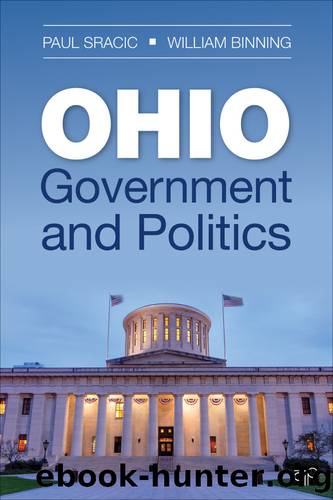Ohio Government and Politics by Paul A. Sracic & William C Binning

Author:Paul A. Sracic & William C Binning [Sracic, Paul A. & Binning, William C]
Language: eng
Format: epub
Tags: American Government, Political Science, State, General
ISBN: 9781483324807
Google: F8lBBwAAQBAJ
Goodreads: 26335859
Publisher: CQ Press
Published: 2015-03-13T00:00:00+00:00
Judicial Selection in Ohio
Under the stateâs first constitution, judges in Ohio were to be elected by the general assembly. When, in 1851, a new constitution was adopted, it made several changes to Ohio judiciary, including providing for the popular election of judges. Ohio is now one of 21 states that allow voters to select their judges at the polls.9
Although Ohio has elected its judges for more than 160 years, the process has undergone some changes. Originally, the political parties nominated judges through various methods, including party conventions. The party affiliation of the judge was then listed on the general election ballot. In 1911, the general assembly passed the Nonpartisan Judiciary Act, which ordered the party affiliation of judges to be removed from the ballot.10 The next year, the Ohio constitution was amended to mandate that the political parties use primaries to select their standard bearers. In practice, this means that judges in Ohio are selected in partisan political primaries and therefore generally must run as Democrats or Republicans. General election voters, however, are not provided with any information on the ballot about the political affiliation of the judicial candidates nominated by the parties. Now, because judges are expected to decide cases in a nonpartisan manner, the use of nonpartisan ballots is not unusual in the United States. Among the states that elect judges, all but seven ban the inclusion of party affiliation on the ballot. Ohio is the only state, however, that combines a nonpartisan general election ballot with partisan primary election system.
The judges and justices, including the chief justice of the Ohio supreme court, are elected to six-year terms. Municipal court judges are elected during odd-numbered years, while all other judges appear on the ballot in even-numbered years. All judges, including the chief justice and justices of the supreme court, can be removed from office by a vote of two-thirds of both houses of the general assembly. If a vacancy occurs on any court, the governor is empowered to make a temporary appointment.
Download
This site does not store any files on its server. We only index and link to content provided by other sites. Please contact the content providers to delete copyright contents if any and email us, we'll remove relevant links or contents immediately.
The Secret History by Donna Tartt(18170)
The Social Justice Warrior Handbook by Lisa De Pasquale(11956)
Thirteen Reasons Why by Jay Asher(8458)
This Is How You Lose Her by Junot Diaz(6443)
Weapons of Math Destruction by Cathy O'Neil(5837)
Zero to One by Peter Thiel(5496)
Beartown by Fredrik Backman(5366)
The Myth of the Strong Leader by Archie Brown(5241)
The Fire Next Time by James Baldwin(5022)
How Democracies Die by Steven Levitsky & Daniel Ziblatt(4965)
Promise Me, Dad by Joe Biden(4909)
Stone's Rules by Roger Stone(4865)
100 Deadly Skills by Clint Emerson(4694)
A Higher Loyalty: Truth, Lies, and Leadership by James Comey(4554)
Rise and Kill First by Ronen Bergman(4547)
Secrecy World by Jake Bernstein(4390)
The David Icke Guide to the Global Conspiracy (and how to end it) by David Icke(4385)
The Farm by Tom Rob Smith(4328)
The Doomsday Machine by Daniel Ellsberg(4249)
